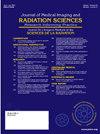Getting Schooled: Insights from an Exploratory Survey on the Academic Preparation for Advanced Practice Radiation Therapy Roles
IF 1.3
Q3 RADIOLOGY, NUCLEAR MEDICINE & MEDICAL IMAGING
Journal of Medical Imaging and Radiation Sciences
Pub Date : 2025-05-01
DOI:10.1016/j.jmir.2025.101920
引用次数: 0
Abstract
Purpose/Aim
As the demand for the Advanced Practice Radiation Therapist (APRT) grows, understanding the preparation pathways for these roles is essential. Currently, there are no APRT education programs in the US or Canada. This study analyzed the APRT perspective on the nature of education and training programs currently being accessed internationally as part of the preparation for advanced practice radiation therapy.
Methods/Process
An exploratory survey was distributed via REDCap to members of the APRT International Community of Practice and US APRT Working Group from July 2 to August 15, 2024, with a total of 56 participants. Demographic data, educational backgrounds, and responses related to advanced practice duties were collected. Statistical associations were analyzed concerning age, years in practice, degree completion, and formal education program attendance. Thematic analysis of qualitative responses was conducted to identify key themes related to APRT preparation.
Results or Benefits/Challenges
Participants were predominantly aged 35-54 (69%) and practice in 11 countries, the majority in Canada (34%) and the UK (34%). Notably, 94% of respondents did not assume advanced practice duties until after at least five years of practice. A significant association was found between the year of degree completion and formal APRT education enrollment (p=0.01), with a positive correlation for those completing degrees after 2015. The majority of participants (84%) completed an advanced degree, however only 45% of those who completed an advanced degree attended a formal education program specifically for their advanced practice role. Of those who did not attend a formal degree for their advanced practice role, the top three reasons were that (in descending order of frequency) there was no suitable program available, that it was not necessary for the position, or that they still plan to complete an APRT specific degree in the future. Thematic analysis of open-ended responses revealed that participants tended to make comments related to the 4 established pillars of advanced practice (education, research, clinical practice, leadership and management). Participants valued clinical judgment, research skills, and technical skills as graduate program essentials. They noted development of clinical expertise, clinical judgement, clinical assessment and psychosocial aspects as shortcomings of existing APRT education programs.
Conclusions/Impact
These international data suggest a pressing need for the development of an optimal APRT preparation model, incorporating essential clinical practice components and addressing identified educational gaps. Future work will include content analysis of existing programs, literature review, and focus groups with stakeholders to develop an ideal APRT preparation model for the US and Canada.
接受教育:对高级实践放射治疗角色的学术准备的探索性调查的见解
随着对高级实践放射治疗师(APRT)需求的增长,了解这些角色的准备途径至关重要。目前,美国和加拿大都没有APRT教育项目。本研究分析了APRT对教育和培训项目性质的看法,目前国际上正在使用这些教育和培训项目作为高级放射治疗准备工作的一部分。方法/过程一项探索性调查于2024年7月2日至8月15日通过REDCap向APRT国际实践社区和美国APRT工作组的成员分发,共有56名参与者。收集了人口统计数据、教育背景和与高级实践职责相关的回答。对年龄、从业年数、学位完成程度和正规教育项目出勤率进行统计分析。对定性反应进行专题分析,以确定与APRT准备相关的关键主题。结果或益处/挑战参与者主要年龄在35-54岁之间(69%),在11个国家进行实践,其中大多数在加拿大(34%)和英国(34%)。值得注意的是,94%的受访者在至少五年的实践之后才承担高级实践职责。完成学位的年份与正规APRT教育入学率之间存在显著相关(p=0.01), 2015年以后完成学位的学生与正规APRT教育入学率呈正相关。大多数参与者(84%)完成了高等学位,然而,只有45%完成了高等学位的人参加了专门针对高级实践角色的正规教育课程。在那些没有参加高级实践职位的正式学位的人中,排名前三位的原因是(按频率降序排列)没有合适的课程,对于该职位来说不是必需的,或者他们仍然计划在未来完成APRT特定的学位。对开放式回答的专题分析显示,参与者倾向于就先进实践的4个既定支柱(教育、研究、临床实践、领导和管理)发表评论。参与者将临床判断、研究技能和技术技能视为研究生课程的基本要素。他们指出,临床专业知识、临床判断、临床评估和心理社会方面的发展是现有APRT教育项目的不足之处。结论/影响这些国际数据表明,迫切需要开发一种最佳的APRT制备模型,包括基本的临床实践组成部分,并解决已确定的教育差距。未来的工作将包括对现有项目的内容分析,文献综述,以及与利益相关者的焦点小组,为美国和加拿大制定理想的APRT准备模式。
本文章由计算机程序翻译,如有差异,请以英文原文为准。
求助全文
约1分钟内获得全文
求助全文
来源期刊

Journal of Medical Imaging and Radiation Sciences
RADIOLOGY, NUCLEAR MEDICINE & MEDICAL IMAGING-
CiteScore
2.30
自引率
11.10%
发文量
231
审稿时长
53 days
期刊介绍:
Journal of Medical Imaging and Radiation Sciences is the official peer-reviewed journal of the Canadian Association of Medical Radiation Technologists. This journal is published four times a year and is circulated to approximately 11,000 medical radiation technologists, libraries and radiology departments throughout Canada, the United States and overseas. The Journal publishes articles on recent research, new technology and techniques, professional practices, technologists viewpoints as well as relevant book reviews.
 求助内容:
求助内容: 应助结果提醒方式:
应助结果提醒方式:


